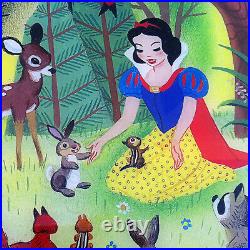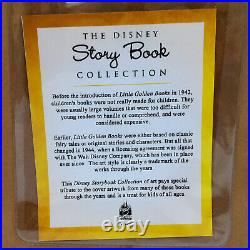Disney Parks WonderGround Art of Golden Books Snow White 13x13 inch Framed Art







This special edition framed print was released in 2014 as part of the Little Golden Books art collection in Disney Parks. It is a reproduction of art from the 1967 Snow White and the Seven Dwarves Golden Book. It features Snow White among the forest animals. The print is in great condition. There is a small dent along the top of the frame.
Please see photos for exact condition. Please send a message with any questions.
Snow White and the Seven Dwarfs is a 1937 American animated musical fantasy film produced by Walt Disney Productions and released by RKO Radio Pictures. Based on the 1812 German fairy tale by the Brothers Grimm, it is the first full-length traditionally animated feature film and the first Disney animated feature film. The story was adapted by storyboard artists Dorothy Ann Blank, Richard Creedon, Merrill De Maris, Otto Englander, Earl Hurd, Dick Rickard, Ted Sears and Webb Smith.
David Hand was the supervising director, while William Cottrell, Wilfred Jackson, Larry Morey, Perce Pearce, and Ben Sharpsteen directed the film's individual sequences. Snow White premiered at the Carthay Circle Theatre in Los Angeles, California on December 21, 1937. The popularity of the film has led to its being re-released theatrically many times, until its home video release in the 1990s. Adjusted for inflation, it is one of the top-ten performers at the North American box office and the highest-grossing animated film.
Worldwide, its inflation-adjusted earnings top the animation list. Snow White was nominated for Best Musical Score at the Academy Awards in 1938, and the next year, producer Walt Disney was awarded an honorary Oscar for the film. This award was unique, consisting of one normal-sized, plus seven miniature Oscar statuettes. They were presented to Disney by Shirley Temple. In 1989, the United States Library of Congress deemed the film "culturally, historically, or aesthetically significant" and selected it as one of the first 25 films for preservation in the National Film Registry. The American Film Institute ranked it among the 100 greatest American films, and also named the film as the greatest American animated film of all time in 2008.Disney's take on the fairy tale has had a significant cultural effect, resulting in popular theme park attractions, a video game, a Broadway musical, and an upcoming live-action film. The primary authority on the design of the film was concept artist Albert Hurter.
All designs used in the film, from characters' appearances to the look of the rocks in the background, had to meet Hurter's approval before being finalized. Two other concept artists-Ferdinand Horvath and Gustaf Tenggren-also contributed to the visual style of Snow White and the Seven Dwarfs.Horvath developed a number of dark concepts for the film, although many other designs he developed were ultimately rejected by the Disney team as less easily translated into animation than Hurter's. Tenggren was used as a color stylist and to determine the staging and atmosphere of many of the scenes in the film, as his style borrowed from the likes of Arthur Rackham and John Bauer and thus possessed the European illustration quality that Walt Disney sought. He also designed the posters for the film and illustrated the press book. However, Horvath didn't receive a credit for the film. Other artists to work on the film included Joe Grant, whose most significant contribution was the design for the Queen's Witch form.
The songs in Snow White and the Seven Dwarfs were composed by Frank Churchill and Larry Morey. Smith and Leigh Harline composed the incidental music score. Well-known songs from the film include "Heigh-Ho", "Someday My Prince Will Come", and "Whistle While You Work". Since Disney did not have its own music publishing company at the time, the publishing rights for the music and songs were administered through Bourne Co.
Music Publishers, which continues to hold these rights. In later years, the studio was able to acquire back the music rights from many of their other films, but not Snow White, Pinocchio, Dumbo or most Silly Symphony cartoons. Snow White became the first American film to have a soundtrack album, released in conjunction with the feature film. Before Snow White and the Seven Dwarfs, a film soundtrack recording was unheard of and of little value to a movie studio. At this time, Disney also encouraged his staff to see a variety of films.These ranged from the mainstream, such as MGM's Romeo and Juliet (1936)-to which Disney made direct reference in a story meeting pertaining to the scene in which Snow White lies in her glass coffin-to the more obscure, including European silent cinema. Snow White and the Seven Dwarfs, as well as the two Disney films to follow it, were also influenced by such German expressionist films as Nosferatu (1922) and The Cabinet of Dr.
Caligari (1920), both of which were recommended by Disney to his staff. This influence is particularly evident in the scenes of Snow White fleeing through the forest and the Queen's transformation into the Witch. The latter scene was also inspired by Dr. Hyde (1931), to which Disney made specific reference in story meetings. Snow White and the Seven Dwarfs premiered at the Carthay Circle Theatre on December 21, 1937.The film received a standing ovation at its completion from an audience that included Judy Garland, Marlene Dietrich and Charles Laughton. Six days later, Walt Disney and the seven dwarfs appeared on the cover of Time magazine. Three weeks later, it opened at the Radio City Music Hall in New York City and a theater in Miami in January 1938, in which the strong box office sales encouraged RKO Radio Pictures to place the film into general release on February 4.
Snow White would soon be displaced from this position by Gone with the Wind in 1939. Snow White and the Seven Dwarfs was first re-released in 1944, to raise revenue for the Disney studio during the World War II period. This re-release set a tradition of re-releasing Disney animated features every few years, and Snow White and the Seven Dwarfs was re-released to theaters in 1952, 1958, 1967, 1975, 1983, 1987 and 1993. Coinciding with the 50th-anniversary release in 1987, Disney released one of many authorized novelizations of the story, this one written by children's author Suzanne Weyn.In 1993, Snow White and the Seven Dwarfs became the first film to be entirely scanned to digital files, manipulated, and recorded back to film. The restoration project was carried out entirely at 4K resolution and 10-bit color depth using the Cineon system (10 bits each of red, green and blue-30 in total) to digitally remove dirt and scratches. Adjusted for inflation, and incorporating subsequent releases, the film still registers one of the top-10 American film moneymakers of all time, and is the highest-grossing animated film. The film was a tremendous critical success, with many reviewers hailing it as a genuine work of art, recommended for both children and adults. Although film histories often state that the animation of the human characters was criticized, more recent scholarship found that contemporary reviewers praised the realistic style of the human animation, with several stating that audiences had forgotten that they are watching animated humans rather than real ones.
Nugent of The New York Times felt that Mr. Disney and his technical crew have outdone themselves. The picture more than matches expectations.It is a classic, as importantly cinematically as The Birth of a Nation or the birth of Mickey Mouse. Nothing quite like it has been done before; and already we have gone impolite enough to clamor for an encore. " Variety observed that "[so] perfect is the illusion, so tender the romance and fantasy, so emotional are certain portions when the acting of the characters strikes a depth comparable to the sincerity of human players, that the film approaches real greatness.
The film's intellectual property has been franchised across a diverse range of mediums, including a Broadway musical, video games and theme park rides. Snow White's success led to Disney moving ahead with more feature-film productions. Within two years, the studio completed Pinocchio and Fantasia and had begun production on features such as Dumbo, Bambi, Alice in Wonderland and Peter Pan. At Disneyland, Snow White and the Evil Queen take a photo with a visitor in 2012. Snow White's Enchanted Wish (named Snow White's Scary Adventures until 2020) is a popular theme park ride at Disneyland (an opening day attraction dating from 1955), Tokyo Disneyland, and Disneyland Paris. Fantasyland at Walt Disney World's Magic Kingdom underwent an expansion from 2012 to 2014. The Snow White's Scary Adventures ride was replaced with Princess Fairytale Hall, where Snow White and other princesses are located for a meet and greet. Included in the 2013 expansion of Fantasyland is the Seven Dwarfs Mine Train roller coaster. Snow White, her Prince, the Queen, and the Seven Dwarfs are also featured in parades and character appearances throughout the parks. Disneyland's Fantasyland Theater hosted Snow White: An Enchanting Musical from 2004 to 2006.